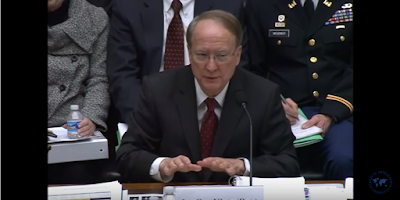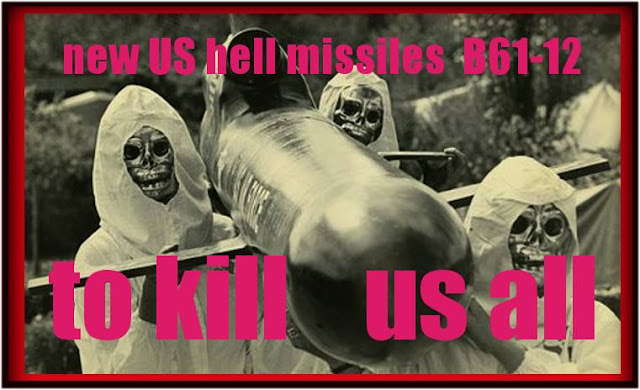Established by Congress in 2000, the NNSA is a semi-autonomous agency within the Department of Energy. While the Defense Department manages the delivery systems of the nuclear force, the agency has oversight over the development, maintenance and disposal of nuclear warheads.
The implementation of the program runs contrary to President Obama’s stated pledge not to create any new nuclear weapons or ones with new military capabilities.
The capability of the new B61-12 nuclear bomb seems to continue to expand, from a simple life-extension of an existing bomb, to the first U.S. guided nuclear gravity bomb, to a nuclear earth-penetrator with increased accuracy.
| B61 |

B61 training unit intended for ground crew. It accurately replicates the shape and size of a “live” B61 (together with its safety/arming mechanisms) but contains only inert materials
|
| Type |
Nuclear bomb |
| Service history |
| Used by |
United States |
| Production history |
| Designer |
Los Alamos National Laboratory |
| Designed |
1963 |
| Manufacturer |
Pantex Plant |
| Produced |
1968 (full production) |
| No. built |
3,155 |
| Specifications |
| Weight |
700 pounds (320 kg) |
| Length |
11 feet 8 inches (3.56 m) |
| Diameter |
13 inches (33 cm) |
|
| Blast yield |
0.3–340 kilotons |
The B61 is a
variable yield bomb (0.3 to 340 kiloton yield in various versions and settings) designed for carriage by high-speed aircraft. It has a streamlined casing capable of withstanding supersonic flight speeds. The weapon is 11 ft 8 in (3.56 m) long, with a diameter of about 13 inches (33 cm). Basic weight is about 700 pounds (320 kg), although the weights of individual weapons may vary depending on version and
fuze/retardation configuration.
Development
A B61 bomb undergoing disassembly.
The B61, known before 1968 as the TX-61, was designed in 1963. It was designed and built by the
Los Alamos National Laboratory in
New Mexico. It began from a program for a lightweight, streamlined weapon launched in 1961. Production engineering began in 1965, with full production beginning in 1968 following a series of development problems.
Total production of all versions was approximately 3,155, of which approximately 1,925 remain in service as of 2002, and some 1,265 are considered to be operational.The
warhead has changed little over the years, although early versions have been upgraded to improve the safety features.
As of late 2013, there were 200 B61 bombs actively in use by the United States.[2] Of these, 180 were deployed with NATO allies in Europe.[3]
Nine versions of the B61 have been produced. Each shares the same “
physics package“, with different
yield options.The newest variant is the B61 Mod 11, deployed in 1997, which is a ground-penetrating
bunker buster.
The Russian
Continuity of Government facility at
Kosvinsky Kamen, finished in early 1996, was designed to resist US earth-penetrating warheads and serves a similar role as the American
Cheyenne Mountain Complex.
[4][5] The timing of the Kosvinsky completion date is regarded as one explanation for U.S. interest in a new nuclear bunker buster and the declaration of the deployment of the B-61 mod 11 in 1997: Kosvinsky is protected by about 1,000 feet (300 m) of
granite.
[6]When the B61 was still classified, aircrew were not allowed to use the term “B61”. Instead, it was referred to as a “shape”, “silver bullet”, or even “external delivery”.
Deployment
B61 bomb in various stages of assembly. The nuclear component is contained in the small, silver cylinder near the upper middle.
The B61 has been deployed by a variety of U.S.
military aircraft. Aircraft cleared for its use have included the
FB-111A,
B-1 Lancer,
B-2 Spirit,
B-52 Stratofortress;
F-101 Voodoo,
F-100 D & F Super Sabre,
F-104 Starfighter,
F/A-18 Hornet,
F-111 Aardvark and
F-4 Phantom II fighter bombers;
A-4 Skyhawk,
A-6 Intruder and
A-7 Corsair II attack aircraft; the
F-15 Eagle,
F-15E Strike Eagle and
F-16 Falcon;
British,
German and
Italian Panavia Tornado IDS aircraft. USAFE and all
NATO dual role aircraft can carry B61s. The
Lockheed S-3 Viking was also able to deploy the B61 as a nuclear depth bomb.
As of 2005, they were deployed in Europe under the
NATO nuclear sharing arrangement.
[8] NATO has agreed to vastly improve the capabilities of this force with the increased accuracy of the B61 Mod 12 upgrade and the delivery of the stealthy F-35.
[9][10] This will, for the first time, add a modest
standoff capability to the B61.
[11]Mod 12
As of 2013, the Pentagon was asking for an $11 billion life-extension program for the B61 bomb, which would be the most ambitious and expensive nuclear warhead refurbishment in history. Congress is opposed to this effort for cost and timeline issues and questions for the B61’s need. Cost estimates have doubled from $4 billion to $8 billion and production slipped from 2017 to 2020, then grew to $10 billion for life extension plus $1 billion for tail guidance kits and production was delayed to 2021. Sequestration budget cuts in early 2013 have delayed any start until 2020. The
Senate Energy and Water Appropriations Subcommittee stated that extending the life of B61s and consolidating its variants may not be a cheap and low-risk method to meet military requirements.
The B61 Mod 12 is to replace the previous Mod 3, 4, 7, and 10 versions with 400–500 planned with a service life of 20 years. Refurbishing the existing variants and eliminating the guidance kit would save $2–3 billion. There are also questions about the future structure of gravity nuclear bombs. European deployments of warheads by NATO countries are cited as a reason for the low-yield Mod 12. With reductions planned of nuclear weapons in Europe, which may retire the older Mod 3 and 4 and the Mod 10 already slated for retirement, and the possibility that European nations may not build or procure new aircraft to carry the Mod 12 would eliminate the need for consolidation into a new type. Congressman
John Garamendi has suggested that the B61 simply be retired and the
B83 nuclear bomb be used instead.
While the B61 was first developed in the 1950s and 1960s, the
B83 nuclear bomb entered service in 1983. The
National Nuclear Security Administration, the Pentagon, and the Air Force have called the B83 a “relic of the Cold War” and believe that deploying a megaton-yield gravity bomb, the highest level nuclear weapon left in the U.S. inventory, to Europe is “inconceivable” at this point. The B61-12 is being pursued as a forward-deployed tactical nuclear weapon to protect NATO and Asian allies, and having a credible American nuclear deterrent may dissuade allies from developing their own nuclear weapons. The B61-12 can be deployed from dual-capable fighter aircraft, as well as planned to arm the F-35 and
Long Range Strike Bomber.
The Air Force says that upgrading the B61 would be “considerably” less expensive than integrating the B83 to additional aircraft. Having a megaton yield that can’t be as varied as the B61 also makes it less flexible and the Air Force is pushing for warheads that would have fewer collateral effects. Recapitalizing the B61 is hoped to lead to the retirement of the B83 to comply with plans for fewer, safer, and more reliable warheads. Retirement of the B83 would result in the elimination of the last megaton-yield U.S. bomb and leave the B61-series as the only U.S. gravity nuclear bomb.
The Pentagon and NNSA have stated that if B61 refurbishment does not begin by 2019, components in the existing weapons could begin to fail.
[12][13] Tom Collina of the
Arms Control Association has said that the new development could complicate arms control efforts with Russia.
[14] In 2014 Congress slashed funding for the project and called for alternates to be studied.
[15]In January 2014, former Air Force Chief of Staff
Norton Schwartz confirmed that the B61-12 nuclear bomb upgrade would have enhanced accuracy and a lower yield with less fallout compared to previous versions of the weapon. Accuracy has not been a guarantee for air-dropped nuclear weapons, so consequently large warheads were needed to effectively impact a target; the B61-11 nuclear earth-penetrator is accurate to 110–170 meters from the desired detonation location, so it requires a 400-kiloton warhead.
The B61-12 is accurate to 30 meters from a target and only requires a 50-kiloton warhead. Schwartz believes that greater accuracy would both improve the weapon and create a different target set it can be useful against. An example is the higher-yield B61-11’s role of attacking underground bunkers that need a ground burst to create a crater and destroy it through the shockwave. A 50-kiloton yield detonating on the ground produces a crater with a radius of 30–68 meters, depending on the density of the surface, effectively putting the bunker within the
circular error probability.
Critics say that
a more accurate and less destructive nuclear weapon would make leaders less cautious about deploying it, but Schwartz says it would deter adversaries more because the U.S. would be more willing to use it in situations where necessary. The B61-12 is also important for modernization of European nuclear stocks. The improved accuracy makes it more effective than the previous B61-3/4 currently deployed to the continent. F-16 and Panavia Tornado aircraft cannot interface with the new bomb due to electronic differences, but NATO countries that are buying the F-35 will be able to utilize it.
[16] The first flight test for an inert B61-12 was conducted in 2015.
[17][18]In November 2015, a test of the B61-12 was conducted where the bomb penetrated underground, showing its potential as a nuclear earth-penetrator. Although ground penetration was not an objective of the Mod 12 upgrade, it could allow it to take up the penetrating mission of the B61-11, which has no life-extension planned and will expire in the 2030s. Being able to penetrate underground increases its effectiveness against buried targets, as it more efficiently transmits explosive energy through enhanced ground-shock coupling, allowing its max yield of 50 kilotons underground to have the equivalent surface-burst capability of a 750 kt to 1.25 megaton weapon. The B61-12’s increased accuracy and earth-penetration capability allows a lower strike yield to be selected, reducing radioactive fallout risk, potentially making it more attractive to military planners.
[19]Design
The B61 is a
variable yield bomb designed for carriage by high-speed aircraft. It has a streamlined casing capable of withstanding supersonic flight speeds. The weapon is 11 ft 8 in (3.58 m) long, with a diameter of about 13 in (33 cm). Basic weight is about 700 lb (320 kg), although the weights of individual weapons may vary, depending on version and
fuze/retardation configuration.
B61 administrative procedures performed by ground-based personnel are executed via an access panel located on the side of the bomb, which opens to reveal 9 dials, 2 sockets and a T-handle which manually triggers the “command disable” function. One of the sockets is a MC4142 “strike enable” plug which must be inserted in order to complete critical circuits in the safety/arming and firing mechanisms. The other socket is the
PAL connector located in the top right hand corner of the arming panel, which has 23 pins marked with alphabetic letter codes.
The B61 also features a “command disable” mechanism, which functions as follows: after entering the correct 3-digit numeric code it is then possible to turn a dial to “DI” and pull back a T-shaped handle which comes away in the user’s hand. This action releases a spring-loaded
firing pin which fires the
percussion cap on an MC4246A
thermal battery, powering it up. Electrical power from the thermal battery is sufficient to “fry” the internal circuitry of the bomb, destroying critical mechanisms without causing detonation. This makes the bomb incapable of being used. Any B61 which has had the command disable facility used must be returned to
Pantex for repair.
[20]The newest variant is the B61 Mod 11, a hardened penetration bomb with a reinforced casing (according to some sources, containing
depleted uranium) and a delayed-action
fuze, allowing it to penetrate several metres into the ground before detonating, damaging fortified structures further underground.
[21] The Mod 11 weighs about 1,200 lb (540 kg). Developed from 1994, the Mod 11 went into service in 1997 replacing the older
megaton-yield
B53 bomb. About 50 Mod 11 bombs have been produced, their warheads converted from Mod 7 bombs. At present, the primary carrier for the B61 Mod 11 is the
B-2 Spirit.
Most versions of the B61 are equipped with a
parachute retarder (currently a 24-ft (7.3 m) diameter
nylon/
Kevlar chute) to slow the weapon in its descent. This offers the aircraft a chance to escape the blast, or allows the weapon to survive impact with the ground in
laydown mode. The B61 can be set for airburst,
ground burst, or laydown detonation, and can be released at speeds up to Mach 2 and altitudes as low as 50 feet (15 m).
The B61 is a variable yield,
kiloton-range weapon called “Full
Fuzing Option”(FUFO) or “
Dial-a-yield” by many service personnel. Tactical versions (Mods 3, 4, and 10) can be set to 0.3, 1.5, 5, 10, 45, 60, 80, or 170 kiloton explosive yield (depending on version).
[22] The strategic version (B61 Mod 7) has four yield options, with a maximum of 340 kilotons. Sources conflict on the yield of the earth-penetrating Mod 11; the
physics package or bomb core components of the Mod 11 are apparently unchanged from the earlier strategic Mod 7; however, the declassified 2001 Nuclear Posture Review
[23] states that the B-61-11 has only a single yield; some sources indicate 10 kt, others suggest the 340 kiloton maximum yield as the Mod 7.
The early Mods 0, 1, 2, and 5 have been retired (Mods 6, 8, and 9 were cancelled before production), and the Mod 10 has been moved to the inactive stockpile, leaving the Mods 3, 4, 7, and 11 as the only variants in active service.
The U.S. intended to refurbish the B61 bombs under its Life Extension Program with the intention that the weapons should remain operational until at least 2025.
[24] However, the United States Congress ordered that this work be stopped, pending reports from the
National Academy of Sciences and
JASON defense advisory panel.
[25]In May 2010 the National Nuclear Security Administration asked Congress for $40 million to redesign the bomb to enable the
Lockheed Martin F-35 Lightning II to carry the weapon internally by 2017.
[26] This version is designated Mod 12.
[27] The four hundred B61-12 bombs will be used by both tactical aircraft (such as the F-35) and strategic aircraft (such as the B-2) and the Tail Subassembly (TSA) will give them
Joint Direct Attack Munition levels of accuracy, allowing the fifty kiloton warhead to have strategic effects from all carrying aircraft.
[28]However, refitting the 400 weapons is now expected to cost over $10 billion.
[29] The B61 Mod 12 tail assembly contract was awarded to
Boeing on November 27, 2012 for $178 million.
[30] Boeing will use their experience with the Joint Direct Attack Munition to yield JDAM equivalent accuracy in a nuclear bomb.
[31] This contract is only the first part of the billion dollar expense of producing and applying the tail kits, over and above the $10 billion cost to refurbish the warheads.
[32]The B61-12 uses an internal guidance system and can glide to its target. The bomb has four selectable yields: 0.3; 5; 10; and 50 kilotons.
[33] On 1 July 2015, the
National Nuclear Security Administration (NNSA) conducted the first of three flight tests of the B61-12 tail kit assembly.
[18]http://en.wikipedia.org/wiki/B61_nuclear_bomb
NNSA IS ALSO IN CHARGE OF ANOTHER PROGRAM WHERE PORK BARREL COSTS HAVE MUSHROOMED FROM 1 BILLION TO 116 BILLION
NNSA – National Nuclear Security Agency Building New Albuquerque Complex MOX Fuel Reprocessing Facility, DOE Building New Savannah River MOX Facility Costs Escalated; From 1 To Over 116 Billion
http://www.agreenroadjournal.com/2014/06/national-nuclear-security-agency-in.html
IT IS TIME TO BAN ALL NUCLEAR WEAPONS AND STOP FEAR MONGERING, PLUS CUT FUNDING FOR MILITARY AND NUCLEAR WEAPONS, DISBAND STANDING ARMY
POPE BACKS NUCLEAR WEAPONS BAN TREATY
VATICAN CITY — Pope Francis says nuclear weapons offer a “false sense of security” and are an ineffective deterrent to 21st-century threats like terrorism, conflict and cybersecurity.
The pontiff spoke as talks on a proposed global nuclear arms ban at the United Nations seem doomed to fail with the U.S., France, Britain and South Korea among nearly 40 countries boycotting the talks.
In a message addressed to the conference in New York, the pope called for “total elimination” of nuclear weapons. He said there were many doubts about the effectiveness of deterrence and warned of “catastrophic humanitarian and environmental consequences” if nuclear weapons were ever used again.
“How sustainable is a stability based on fear, when it actually increases fear and undermines relationships of trust?” Francis asked. “International peace and stability cannot be based on a false sense of security, on the threat of mutual destruction or total annihilation, or on simply maintaining a balance of power.”
The pope said the elimination of nuclear weapons was a “moral and humanitarian imperative” and stressed it was possible to achieve.









